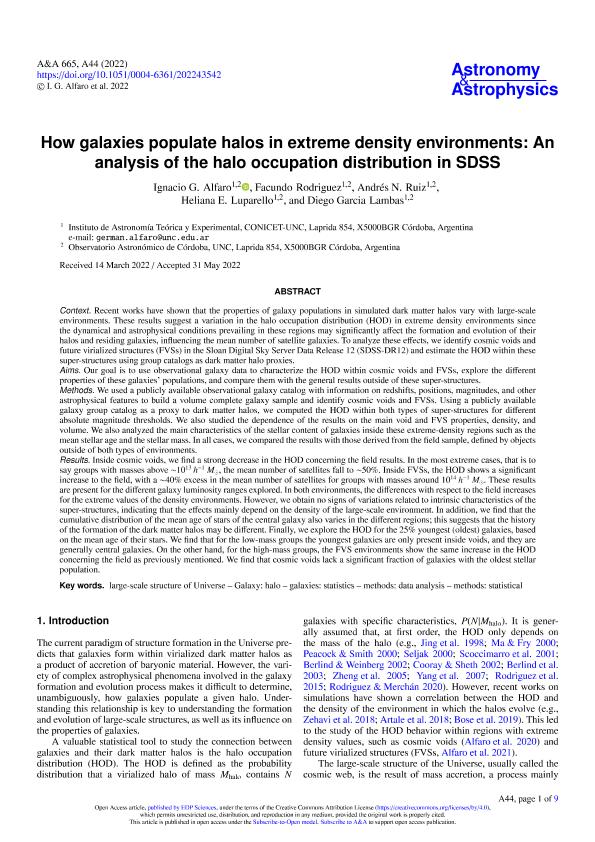Artículo
How galaxies populate halos in extreme density environments: An analysis of the halo occupation distribution in SDSS
Alfaro, Ignacio Germán ; Rodriguez, Facundo
; Rodriguez, Facundo ; Ruiz, Andrés Nicolás
; Ruiz, Andrés Nicolás ; Luparello, Heliana Estefanía
; Luparello, Heliana Estefanía ; Garcia Lambas, Diego Rodolfo
; Garcia Lambas, Diego Rodolfo
 ; Rodriguez, Facundo
; Rodriguez, Facundo ; Ruiz, Andrés Nicolás
; Ruiz, Andrés Nicolás ; Luparello, Heliana Estefanía
; Luparello, Heliana Estefanía ; Garcia Lambas, Diego Rodolfo
; Garcia Lambas, Diego Rodolfo
Fecha de publicación:
09/2022
Editorial:
EDP Sciences
Revista:
Astronomy and Astrophysics
ISSN:
0004-6361
Idioma:
Inglés
Tipo de recurso:
Artículo publicado
Clasificación temática:
Resumen
Context. Recent works have shown that the properties of galaxy populations in simulated dark matter halos vary with large-scale environments. These results suggest a variation in the halo occupation distribution (HOD) in extreme density environments since the dynamical and astrophysical conditions prevailing in these regions may significantly affect the formation and evolution of their halos and residing galaxies, influencing the mean number of satellite galaxies. To analyze these effects, we identify cosmic voids and future virialized structures (FVSs) in the Sloan Digital Sky Server Data Release 12 (SDSS-DR12) and estimate the HOD within these super-structures using group catalogs as dark matter halo proxies. Aims. Our goal is to use observational galaxy data to characterize the HOD within cosmic voids and FVSs, explore the different properties of these galaxiesa'populations, and compare them with the general results outside of these super-structures. Methods. We used a publicly available observational galaxy catalog with information on redshifts, positions, magnitudes, and other astrophysical features to build a volume complete galaxy sample and identify cosmic voids and FVSs. Using a publicly available galaxy group catalog as a proxy to dark matter halos, we computed the HOD within both types of super-structures for different absolute magnitude thresholds. We also studied the dependence of the results on the main void and FVS properties, density, and volume. We also analyzed the main characteristics of the stellar content of galaxies inside these extreme-density regions such as the mean stellar age and the stellar mass. In all cases, we compared the results with those derived from the field sample, defined by objects outside of both types of environments. Results. Inside cosmic voids, we find a strong decrease in the HOD concerning the field results. In the most extreme cases, that is to say groups with masses above ã1013h-1M, the mean number of satellites fall to ã50%. Inside FVSs, the HOD shows a significant increase to the field, with a ã40% excess in the mean number of satellites for groups with masses around 1014h-1M. These results are present for the different galaxy luminosity ranges explored. In both environments, the differences with respect to the field increases for the extreme values of the density environments. However, we obtain no signs of variations related to intrinsic characteristics of the super-structures, indicating that the effects mainly depend on the density of the large-scale environment. In addition, we find that the cumulative distribution of the mean age of stars of the central galaxy also varies in the different regions; this suggests that the history of the formation of the dark matter halos may be different. Finally, we explore the HOD for the 25% youngest (oldest) galaxies, based on the mean age of their stars. We find that for the low-mass groups the youngest galaxies are only present inside voids, and they are generally central galaxies. On the other hand, for the high-mass groups, the FVS environments show the same increase in the HOD concerning the field as previously mentioned. We find that cosmic voids lack a significant fraction of galaxies with the oldest stellar population.
Archivos asociados
Licencia
Identificadores
Colecciones
Articulos(IATE)
Articulos de INST.DE ASTRONOMIA TEORICA Y EXPERIMENTAL
Articulos de INST.DE ASTRONOMIA TEORICA Y EXPERIMENTAL
Citación
Alfaro, Ignacio Germán; Rodriguez, Facundo; Ruiz, Andrés Nicolás; Luparello, Heliana Estefanía; Garcia Lambas, Diego Rodolfo; How galaxies populate halos in extreme density environments: An analysis of the halo occupation distribution in SDSS; EDP Sciences; Astronomy and Astrophysics; 665; A44; 9-2022; 1-9
Compartir
Altmétricas



